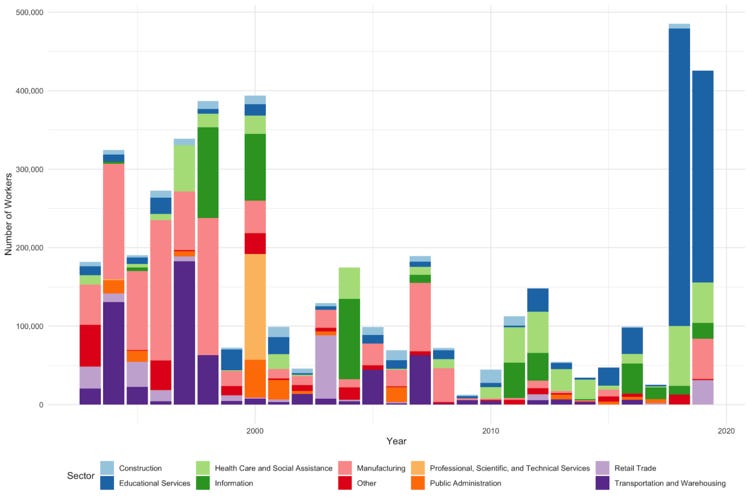Strikewave
Very meta e-mail title today. Let’s get into it.
The Strikewave
With several large-scale strikes underway or looming, there’s been renewed chatter as to whether we’re in a strike wave. The potential for massive strikes by IATSE and the unions representing Kaiser Permanente workers certainly reinforce the sense of increased worker activity.
It’s somewhat overstated. There’s admittedly been an increase; to date, the number of large strikes (strikes with over 1,000 workers) already exceeds all large strikes in 2020. That’s not in of itself a major accomplishment — 2020 saw extreme lows in large-scale strike activity (except in healthcare), largely as a result of the beginning of the Covid-19 pandemic. Right now, there have been a total of approximately 11 large strikes beginning in 2021. That’s compared to:
2020: 8
2019: 25
2018: 20
2017: 7
2016: 15
2015: 12
In short, the likely sum of large scale strikes in 2021 will not exceed (or match) the strike activity in 2018/2019. Likewise, the total number of workers involved will almost certainly fail to match 2018 and 2019.
So is that reason for dismay? No, it’s not — and here’s why.
Spreading Activity
The BLS tracks three categories of strike: private industry, local government, and state government.
Unsurprisingly, local government and state government (combined) have dominated strike activity — a result of organized labor’s higher strength in the public sector vs. the private sector. Over half of strikes in 2018 and 2019 were public sector strikes, with large-scale education strikes making up the bulk of strike activity, followed by nursing.

That’s not the case in 2021. In fact, 2021 is unique in the near total absence of large-scale public sector strikes, and the high volume of large-scale private sector strikes.
2021 is on pace to end with the smallest number of large public sector strikes — 1 — in well over a decade, and with the highest number of private sector strikes — 11 or more — since at least 2012. That number could spike significantly if IATSE and the Kaiser Permanente unions take strike action. In other words, the total numbers conceal a remarkable decrease in public sector strike activity (more later) and a remarkable increase in private sector strike activity, with much of it coming in the last quarter of 2021.
Moreover, the private sector strikes are more spread through a number of sectors rather than concentrated in one or two areas of the economy. Strikes have hit food production, wholesale distributors, metal manufacturers, mining operators, auto manufacturers, private universities, and healthcare facilities, and could spread to the entertainment industry. In contrast, private sector strikes in 2019 (totaling 10) were highly clustered in healthcare and manufacturing, with most of the latter driven by the General Motors and Mack Truck strikes.
The fact that fewer workers are involved compared to 2018 and 2019 may seem like a cause for alarm — but it’s important to recall that 2018 and 2019’s figures were inflated by large-scale, single-day statewide strike actions in states like North Carolina. So, to sum: private sector strike activity is not only growing, it’s spreading throughout the economy in a fashion largely unseen in over a decade.
Conclusion
So why is the public sector — normally a reliable source of strike activity — silent?
It’s difficult to measure why something doesn’t happen, but there are some reasonable guesses. Many public sector workers were shifted into remote work by the Covid-19 pandemic. Public sector unions have largely focused on impact bargaining over workplace safety and returns to work, with the Chicago Teachers Union and United Teachers of Los Angeles examples of protracted struggles with management over pandemic working conditions. Many unions agreed to short-term contract extensions with the intent of carrying them through the Covid-19 pandemic. Activity hasn’t ceased altogether — it’s simply been happening through other means.
The lack of public sector strike activity should be viewed as an aberration likely attributable to the pandemic. If we assumed average strike activity in local and state government, there would be at least 7 additional strikes to add to 2021’s total, making 2021 a well-above average year for large-scale strike activity. If we more accurately assumed that it would be on the higher end of the average, 2021 would be one of the biggest years for strike activity in two decades.
In short: saying there’s a strike wave is premature. We are, however, seeing the recipe of the beginning of a strike wave — one that may significantly outstrip the strikes in 2018 and 2019 in scope and breadth.
Strike Funds
Appropriately, I’m going to start dropping links to strike funds with each newsletter.
CWA 1133 at Catholic Health in Buffalo, New York
BCTGM Local 374G at Kellogg’s in Lancaster, Pennsylvania
UMWA at Warrior Met in Brookwood, Alabama
MNA at St. Vincent’s Hospital in Worcester, Massachusetts
Reading & Writing
Nothing major on the reading front — I’m finally going to read through Joshua Clover’s book Riot. Strike. Riot. I’m also reading Gabriel Winant’s book The Next Shift, which covers the decline of manufacturing in the Rust Belt and the rise of the healthcare sector.
I wrote about the Catholic Health strike for The Nation. Check it out here.
In solidarity,
Connor

